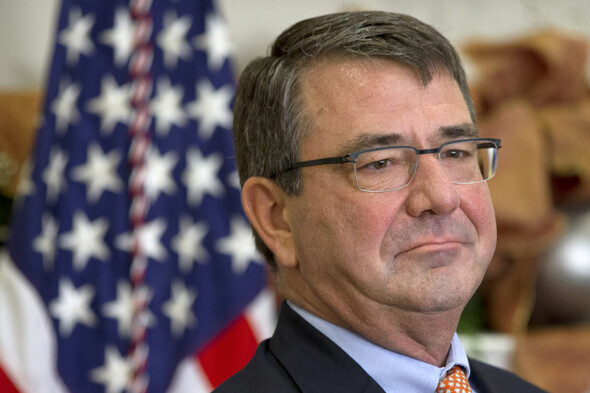hankyoreh
Links to other country sites 다른 나라 사이트 링크
S. Korea and the US agree in principle to deploy THAAD system

On Mar. 22, US Defense Secretary Ashton Carter said the US and South Korea are discussing the deployment of THAAD (Terminal High Altitude Area Defense) on the Korean Peninsula and that the two countries had agreed in principle to deploy the anti-ballistic missile system.
While the South Korean Defense Ministry has already treated the THAAD deployment as an accomplished fact, this is the first time for a high-ranking official in the US government to confirm it.
After making this statement in a hearing about the defense budget before the House Armed Services Committee, Carter said that the reason for deploying THAAD is “to be able to protect the entirety of the peninsula against North Korean missiles of greater range.”
“That’s why we want to add THAAD to the already existing Patriots, both South Korean Patriots and U.S. Patriots,” he said.
Immediately after North Korea followed its fourth nuclear test this past January by launching a long-range missile in February, the US and South Korea announced that they were initiating official deliberations about how to deploy THAAD.
While there had been some speculation that the two countries would postpone the deployment of THAAD in exchange for China’s cooperation in tougher sanctions against North Korea, the US and South Korea officially launched a joint working group to deliberate the deployment of THAAD on Mar. 4.
“Deliberations in the joint working group are addressing the selection of an appropriate site for deploying THAAD along with issues of safety, the environment and cost. Once the deliberations have made some progress, this will be brought to the attention of the public,” said a source in the South Korean military.
Some of the possible sites mentioned for deploying THAAD include Pyeongtaek, Wonju, Daegu and Chilgol.
Taking into account China’s strong opposition to the deployment of THAAD, US officials also appear to be considering the option of trying to make the case to China directly. In this case, it is very likely that the question of deploying THAAD would be decided through negotiations between the US and China.
Nevertheless, it is thought that a final decision has not been reached about the deployment of THAAD in South Korea even inside the US.
“This is a very sensitive issue for the partners throughout the region, especially when you look at South Korea, one of [China’s] largest trading partners [. . .] so we don’t minimize the sensitivity of these discussions,” said US Lieutenant General David Mann, who heads up the US Army Space and Missile Defense Command. Mann spoke with reporters from a defense industry publication on Wednesday.
By Lee Yong-in, Washington correspondent and Park Byong-su, senior staff writer
Please direct questions or comments to [english@hani.co.kr]

Editorial・opinion
![[Editorial] Yoon must halt procurement of SM-3 interceptor missiles [Editorial] Yoon must halt procurement of SM-3 interceptor missiles](https://flexible.img.hani.co.kr/flexible/normal/500/300/imgdb/child/2024/0501/17145495551605_1717145495195344.jpg) [Editorial] Yoon must halt procurement of SM-3 interceptor missiles
[Editorial] Yoon must halt procurement of SM-3 interceptor missiles![[Guest essay] Maybe Korea’s rapid population decline is an opportunity, not a crisis [Guest essay] Maybe Korea’s rapid population decline is an opportunity, not a crisis](https://flexible.img.hani.co.kr/flexible/normal/500/300/imgdb/original/2024/0430/9417144634983596.jpg) [Guest essay] Maybe Korea’s rapid population decline is an opportunity, not a crisis
[Guest essay] Maybe Korea’s rapid population decline is an opportunity, not a crisis- [Column] Can Yoon steer diplomacy with Russia, China back on track?
- [Column] Season 2 of special prosecutor probe may be coming to Korea soon
- [Column] Park Geun-hye déjà vu in Yoon Suk-yeol
- [Editorial] New weight of N. Korea’s nuclear threats makes dialogue all the more urgent
- [Guest essay] The real reason Korea’s new right wants to dub Rhee a founding father
- [Column] ‘Choson’: Is it time we start referring to N. Korea in its own terms?
- [Editorial] Japan’s rewriting of history with Korea has gone too far
- [Column] The president’s questionable capacity for dialogue
Most viewed articles
- 1Months and months of overdue wages are pushing migrant workers in Korea into debt
- 2At heart of West’s handwringing over Chinese ‘overcapacity,’ a battle to lead key future industries
- 3[Editorial] Yoon must halt procurement of SM-3 interceptor missiles
- 4Fruitless Yoon-Lee summit inflames partisan tensions in Korea
- 5Trump asks why US would defend Korea, hints at hiking Seoul’s defense cost burden
- 6Dermatology, plastic surgery drove record medical tourism to Korea in 2023
- 71 in 3 S. Korean security experts support nuclear armament, CSIS finds
- 8[Editorial] New weight of N. Korea’s nuclear threats makes dialogue all the more urgent
- 9South Korea officially an aged society just 17 years after becoming aging society
- 10[Column] For K-pop idols, is all love forbidden love?